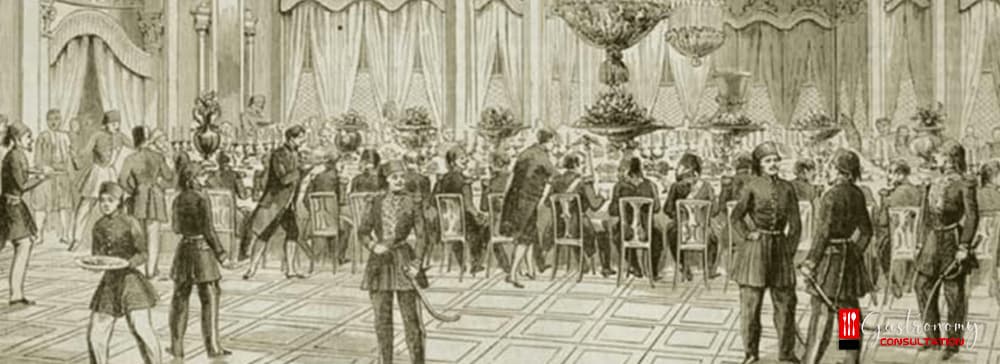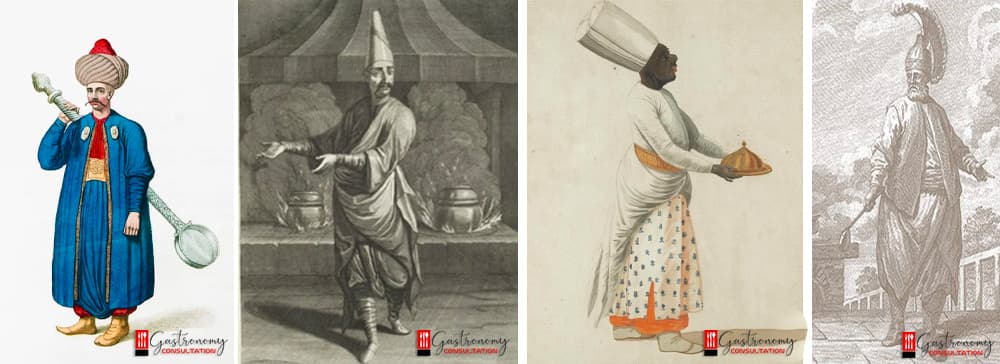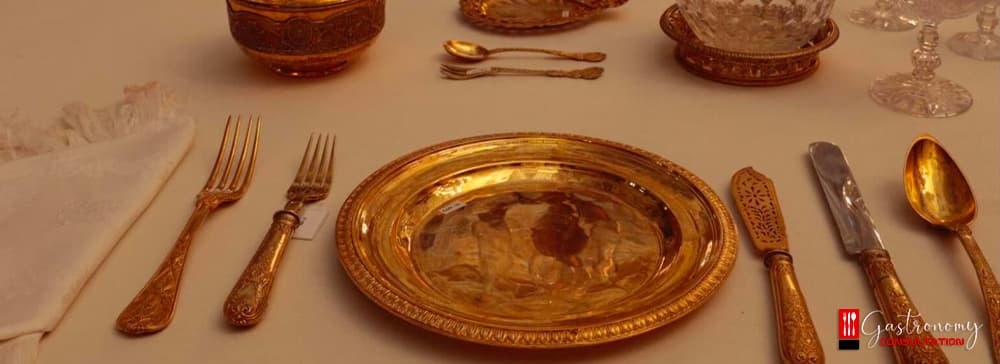Rice was also used more than other grains in this period. “Vienna barley entered the kitchen during this period.” Francala bread is a clear reflection of French influence. Albanian and Dutch cheeses are among the innovations of this period.59 In the Ottoman palace cuisine of the 19th century...
Change in Ottoman Palace Cuisine in the 19th Century
Ottoman palace cuisine appears in a multi-layered form in the last period of the empire. It has many features and differs from the classical period in some points. There have been some changes in the materials used for centuries, table manners and cooking techniques. The adoption of some European cultural characteristics can also be cited as a reason for this change.58 The 19th century was a turning point for Ottoman palace cuisine. As innovation shows itself in every field, we see its effects in the kitchen in this period as well.
Rice was also used more than other grains in this period. “Vienna barley entered the kitchen during this period.” Francala bread is a clear reflection of French influence. Albanian and Dutch cheeses are among the innovations of this period.59 In the
Ottoman palace cuisine of the 19th century, American origin; We see that new vegetables such as tomatoes, potatoes, fresh peppers, beans, Jerusalem artichokes, pumpkins, squash and corn are widely used. “Tomato entered the Ottoman Empire in the 1690s and was previously consumed as green.” Its consumption in red corresponds to the 19th century. However, the use of tomato and tomato paste was not in its current sense, but its use in food was more limited. “The use of cork is only found in the accounting books of the 1870s.” Tin cans with asparagus, mushrooms, artichokes, 19.
From the second half of the 19th century, European-style banquets began to be given in Ottoman cuisine. Tables, chairs, personalized service sets, cutlery were prepared as in Europe. Some French dishes were blended with traditional Ottoman dishes. At the beginning of the 20th century, it was mostly French cuisine. “Champagne sauces, truffles, foie gras, asparagus, cakes and tarts are examples.”
In the 19th century, the variety of spices was less than in the Classical period. In the classical period; While saffron, musk, coriander and gum are in the foreground, the most preferred spices recently; red pepper, allspice and vanilla. Cinnamon is used in both sweet and savory dishes. Red pepper, vanilla, cardamom, and allspice are spices that were introduced in the 19th century and easily adapted to the kitchen.61
Onion juice was used to marinate the meat. kebabs; It was cooked on skewers, pots, stoves, coals, and ovens. Cutlet was made by grilling fillet meat. Stews prepared with mutton, lamb, rabbit, chicken and trotter are other common cooking methods. Meatballs were usually prepared with minced lamb and mutton. The other cooking method technique was the frying method, also called pan. Fish and beef stews were also preferred.
By cooking with little water and olive oil, the pilaki were both delicious and healthy.
The remarkable change of the Ottoman cuisine in the last period compared to the classical period is the separation of salty, sweet and sour flavors in the dishes and the simplification in the use of spices. For example, as in the Classical period, meat and fruits were not used together much. It has developed its already existing cultural richness within the framework of fine tastes over time and a synthesis culture has been revealed with a superior taste.62
One of the pillars of change is the use of olive oil in the Ottoman Empire. Although they lived in lands full of olive groves, they preferred to cook with butter, clarified butter and lard. They used olive oil in soap making, medicines, and machine lubrication. Olive oil has always been one of the products in the category of basic and compulsory needs of the people. Edremit, Ayvalık, Midilli regions were the regions where olive oil was bought the most. Olive oil consumption has increased recently compared to the Classical period. In the 19th century, olive production was refined more carefully.63
Another change is the increase in the variety of vegetables and fruits. Interaction with European cuisine has increased the importance given to vegetables and dishes. The use of canned vegetables is also a feature that came with European influence in this period. Honey and molasses, which are used as sweeteners, have mostly been replaced by sugar. We can say that the most important changes of the last period are tea, chocolate and vanilla. For a kitchen that has not been acquainted with these products before, such a harmony is admirable. There has been a large increase in sweet varieties and the European influence shows itself in this area as well. Turkey meat is another different food seen in this period and it took its place on the tables as much as other poultry. Pineapple sorbet, truffle rice, asparagus with tartar sauce,
While purchasing food for the Ottoman palace, the best types of food were selected. This job required a lot of attention. from the country; Foods such as rice, spices, fruits, jams and pickles were brought. Istanbul had a rich food variety. Fruits and vegetables from the gardens of the Ottoman palace, butter, milk and yoghurt from dairy farms were sent to the palace. Milk and dairy products have been indispensable foods for Turks since Central Asia. “Parmesan cheese is also found in the palace in the late period.” The oil used in the leading role is plain oil called “revgan-ı” as it was in the old times.
Although the food culture in the
Ottoman palace cuisine did not undergo a radical change, there are such differences between the classical period and the last period. Recently introduced foods are one of the most important reasons for this. Another reason is the Europeanization effort that came with the recognition of French cuisine at the top in terms of gastronomy at that time in the world.65
3.2. 19th Century Ottoman Cookbook “Kitabü't Tabbâhîn”
“Kitabü't Tabbâhîn”, the food manuscript of Muhammed Kamil, which is thought to have been written in the 19th century, is a work of 2018 that has just been deciphered. With its inclusion in Turkish culinary literature, it has created a new resource for the researcher. The analysis of the book consists of 4 stages. These; Latinizing the work, creating a dictionary so that it can be understood with today's Turkish, photographing the applicable recipes, and determining the nutritional values. The 214 translated recipes are divided into groups. These groups are; soups, appetizers, meat, offal, poultry and game animals, seafood, vegetables and fruits, rice, pasta and cereals, pastries and buns, desserts and beverages.
The use of mainly animal fat, the preference of lamb and mutton in recipes as meat products, the wide range of spices used, the importance of cinnamon for the 19th century, and the combination of boiling and frying techniques for the same dish are interesting details. The spice that is frequently preferred in the recipes in the work is cinnamon. Muhammed Kamil listed the usage areas of cinnamon spice and talked about its importance. The amount of salt in the recipes is very less compared to today. According to this result, we understand that salt was not popular in our recent history, and flavoring was provided with spices.66
It is necessary to mention the original form of the work, it is an interdisciplinary manuscript. It is known that its author, Muhammed Kamil, was one of the teachers of the Mekteb-i Tıbbiye-i Adliye. There are many pages that were used as drafts in the original manuscript. Some parts have been crossed out, and some parts have been completely removed. This situation has caused deficiencies in Latinized studies. It is impossible to provide a full translation. It is estimated that the manuscript is one of the first works of Ottoman Kitchen.67
The recipes in the work are still consumed today. Recipes from different food groups are given below.
Hünkar Tarhana Soup: 350 gr. 1 bread crumb (in original bakery bread) is beaten in a stone mortar. After being beaten, it is kept in this condition overnight. The mixture obtained in the morning is taken into the cooking pot and cooked for about an hour with the broth until it thickens (neither too liquid or puree). Using milk and cream, if any, while brewing on the stove greatly increases its flavor. It is served with cubes of bread, preferably fried in butter, sprinkled with the right amount of spice.68
Crushed Chicken Kebab: After a chicken is plucked and cleaned, it is made ready by ironing the remaining feathered parts with wax. The chicken is divided into six parts by breaking the joints. It is rubbed in cold water with salt and onion until it turns white foam. This process is applied to remove the chicken smell. Hari is cooked on a strong ember until the pieces are browned. It is then transferred to another pot. In the other bowl, the onion is fried with butter (milk fat). If it is not fresh in season, dried parsley is added. Add some cayenne pepper. After the salt and spices are discarded, it is added to the chicken pot. After adding water to cover it, it is cooked on a strong ember for 1.5 hours. It is served on a flat plate.69

Sweet Meat: The neck part of the mutton must be used. After the neck is washed well and divided into four or five parts, it is sealed in hot ghee. Onions are added to the frying oil to add flavor. The consistency of the meat should be neither dry nor wet. The cooked ones are taken into a separate pot. The hot oil is also filtered and put into the pan. Add enough water to cover the meat. Add enough salt. Then, grape molasses is poured in such a way that it covers a finger over the water. It is kept on the stove until cooked. After cooking, it is immediately taken out to the pan without waiting in the pot. It is served by sprinkling allspice and cinnamon on top.70
DefneliŞiş Kebab: The meat (thigh) extracted from the rough parts of the sheep is left to season with two onions and salt. The finishing time should be about 2 hours. After finishing, the meats are arranged on the kebab skewers by adding bay leaves between them, neither too tight nor loose. The skewers are cooked on a medium charcoal fire. To give softness to the fried meat, butter is applied with a clean goose down. When the meat is close to cooking, a bed of parsley and spring onions is made on a plate. Cooked meats are placed on this bed. No need to spice it up anymore. If it is not in season, basil can be used instead of bay leaf.71
Eggs with Spinach: Fresh spinach leaves are chopped like lettuce and boiled in a pot. After the water is filtered, it is put on the fire with the same pot again. After it starts to absorb its water, two onion sizes and dry onions are added to half a kilo. When the onions soften, add two tablespoons of butter. After adding salt, the cooked greens are poured into either a fried egg or egg pan. Minced meat is roasted in a separate bowl. For the cooked minced meat, eye sockets are opened on the spinach and the minced meat is added here. They are cooked in this way for a while after adding ghee on them. Once the butter melts, the eggs break. It is cooked until the white rises and the yolk is half cooked. It is served quickly. In cases where spinach is not available, chard, poppy or beet leaves can be used.72
Stuffed Okra: The heads of the small but wide ones of the okra are cut off. After they are cut, the insides are hollowed out with a small pocket knife. Three tablespoons of butter, two chopped onions and a tomato are added to a pan and fried. Add 4 cups of water and 2 cups of rice to this mixture. Add enough salt and spices and let it cook. After the water is drawn, it is taken from the fire. The rice mortar is stuffed into the okra. The cut okra heads, on the other hand, are closed over the stuffing as a cover. Arrange the casserole in two or three rows on top of each other. Boiling broth is added and the casserole is covered with a clean tile. It is served after about an hour of cooking.73

Stuffed Artichokes: Artichokes are boiled and carved from the stem and the inside is taken out. A stuffing like stuffed eggplant with olive oil is prepared. The carved fresh parts of the artichoke are also added to this interior. The cavities are filled with mortar. Put it in a pot and cook for an hour. Preferably, a stuffing with minced meat can also be prepared. Clarified butter is added to the stuffed stuffed in the pot. After adding water, the tile is covered and left to cook. If the stuffing is prepared with meat, when it is taken to the plate, cinnamon is sprinkled on it to remove the heavy smell of the meat. It is served juicy after one hour of cooking.74
Mihrab Pastry: Three spoons of burnt butter and salt are added to lye. Then five or six eggs are broken and shaken well. After getting the consistency and kneading, the balls are cut in equal parts. Two different interior mortars are prepared according to preference. The first is made by adding minced meat and parsley to the roasted onion, and the second is made by breaking eggs into cheese or onions. The hands are dipped in flour and the meringues are sprinkled with chicken feathers and clarified butter and rolled out with a rolling pin.
The remaining part from the sides is folded inward and closed on it. Place on a greased tray. The prepared inner mortar is poured into the dough. After drizzling butter on it, it is baked in the oven until golden brown. In the meantime, the pastry begins to rise. Served hot.75
Whole Stuffed Cabbage: It is prepared by taking a tight-leafed cabbage, removing the stems and hollowing it out. In a separate pot, the mortar is prepared as if it were ground meat, peanuts and lamb. It is cooked until it reaches a consistency close to porridge. The inside of the carved cabbage is salted and this mortar is filled by adding a spoonful of clarified butter. A cover is made for stuffed cabbage from the plucked stems. Again, two or three spoons of ghee is applied on the stuffing. Afterwards, the dolma is wrapped with the shirt oil coming out of the candlestick. It is cooked in an oven or tandoor. It is served hot after about an hour of cooking.

Persian Rice: 300 gr cubed meat is made from the fatty part of the mutton. In order to prevent it from burning, leg bones are arranged at the bottom of the pot. Cubed meat is roasted in this way. A lot of right is added on it. Sorted rice is added to the roasted meat and kept on fire until cooked. The peculiarity of this pilaf is that it contains a kind of grape and pine nut, which the Persian calls "quiche". The size of the rice is two to one and the quality of the rice is important. After the rice is cooked, it is placed on a plate and garnished with grapes, pistachios and fresh parsley, and spices are added. It is a demanding meal that is ready in about 1.5 hours.77
Meatless Rice: Finely dice five to fifteen onions, rub them with enough salt, add water and bring it to pulp consistency. This mixture is filtered without adding additional salt. Bulgur or rice is added in one to two measures and water is added. If the rice is broken, the amount of water is reduced so that it does not become mush. It is taken close to drawing water from the hot fire and left on the ash embers. After absorbing the water, butter is poured over it. After brewing for half an hour, it is served by sprinkling allspice and black pepper.78
Sütlü Aş (rice pudding): 300 gr rice is cleaned. The cleaned rice is boiled in water until it becomes soft. Approximately 2.5 kg of milk is boiled in a separate pot. Rice is added to boiling milk and cooked together for a while. This ensures that the rice is fully cooked. The mixture is taken from the high fire and poured into the plates or plates. It is a little infused on ash embers to keep cream. After cooling, add enough sugar on it. In order to burn the cream well, granulated sugar can be sprinkled preferably while it is on the fire. It is served cold or hot.
Quince Dessert with Cream: Quince, apple or pear are peeled thinly and kept in cold water. The quince is divided into four parts and the apple or pear into two parts and the seeds are cleaned. The extracted cores are tied cleanly with a cheesecloth. Suppose we are using quince. Quinces are put in boiling water. Half a kilo of boiling water is enough for three quinces. After two quarts of boiling, quinces are taken with a colander. Sufficient sugar is poured into the boiling water. For cutting, lemon juice or egg is used. The quinces are put into this pot again. While boiling, the beans wrapped in cheesecloth are also added. After cooking together for about five minutes, they are placed on the plate by paying attention to their shape. It is served garnished with cream and pistachio.79